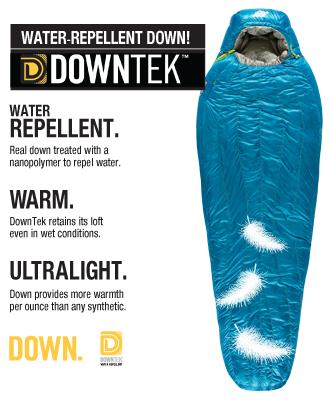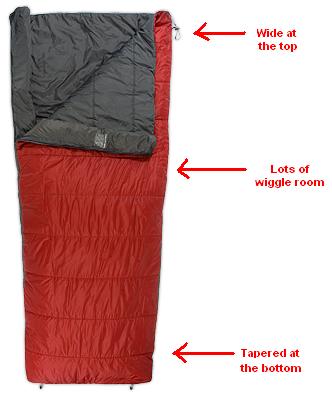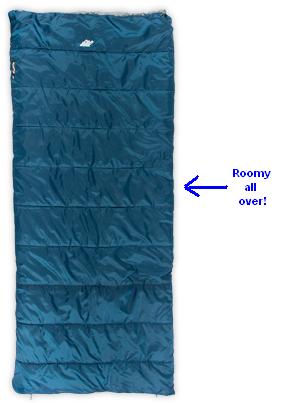How to Choose a Sleeping Bag
At the end of an action-packed day outside, there's nothing like crawling into a comfy sleeping bag to rest up for the next day’s adventure. To help you narrow your selection and find the perfect sleeping bag for you, here are a few important things to consider and comfort-enhancing features to look for.
SLEEPING BAGS TEMPERATURE RATINGS All sleeping bags have a recommended temperature rating. It refers to the lowest temperature the bag is suitable for. However, because outside factors like your metabolic rate and the sleeping pad you use will also affect how warmly (or coldly) you sleep, it's probably best to mentally add about 10° when searching for the right bag. This means you should think of a 20° bag as a 30° bag, -20° as -10°, and so on.
DOWN SLEEPING BAGS Goose down is the lightest, most compressible insulator available, giving it an extraordinarily high warmth-to-weight ratio. That means that a 20° down sleeping bag will weigh less than a 20° synthetic sleeping bag, which is important for backpackers who need to pack as efficiently as possible.
Because it retains its superior insulating qualities for years and years, down is also a terrific investment. The disadvantage of down is that when it gets wet it stops insulating and becomes heavier.
Down Jargon When you’re looking at sleeping bags (or any other product) that contains down, there are a few terms you’ll likely encounter. Knowing what each term means can be helpful in your decision-making process. Here’s what you need to know:
i. Fill—Down's insulating ability is measured in “fill power,” which refers to the number of cubic inches one ounce of down will fill when allowed to reach its maximum loft. Higher numbers mean that less down is required to keep you warm, which in turn means that the bag will weigh less.
If the concept of fill power is confusing, just keep this in mind: 400-450 fill = OK; 500-550 fill = Good; 600-750 = Better; 750+ fill = Best.
ii. Loft—Essentially, when talking about how much loft down has, we’re really talking about how fluffy it is. (“Loft” just sounds more technical than “fluffy.”) One of the best qualities of a down sleeping bag is that no matter how tightly you compress it, it will regain its loft once you take it out of the stuff sack.
At the end of an action-packed day outside, there's nothing like crawling into a comfy sleeping bag to rest up for the next day’s adventure. To help you narrow your selection and find the perfect sleeping bag for you, here are a few important things to consider and comfort-enhancing features to look for.
SLEEPING BAGS TEMPERATURE RATINGS All sleeping bags have a recommended temperature rating. It refers to the lowest temperature the bag is suitable for. However, because outside factors like your metabolic rate and the sleeping pad you use will also affect how warmly (or coldly) you sleep, it's probably best to mentally add about 10° when searching for the right bag. This means you should think of a 20° bag as a 30° bag, -20° as -10°, and so on.
DOWN SLEEPING BAGS Goose down is the lightest, most compressible insulator available, giving it an extraordinarily high warmth-to-weight ratio. That means that a 20° down sleeping bag will weigh less than a 20° synthetic sleeping bag, which is important for backpackers who need to pack as efficiently as possible.
Because it retains its superior insulating qualities for years and years, down is also a terrific investment. The disadvantage of down is that when it gets wet it stops insulating and becomes heavier.
Down Jargon When you’re looking at sleeping bags (or any other product) that contains down, there are a few terms you’ll likely encounter. Knowing what each term means can be helpful in your decision-making process. Here’s what you need to know:
i. Fill—Down's insulating ability is measured in “fill power,” which refers to the number of cubic inches one ounce of down will fill when allowed to reach its maximum loft. Higher numbers mean that less down is required to keep you warm, which in turn means that the bag will weigh less.
If the concept of fill power is confusing, just keep this in mind: 400-450 fill = OK; 500-550 fill = Good; 600-750 = Better; 750+ fill = Best.
ii. Loft—Essentially, when talking about how much loft down has, we’re really talking about how fluffy it is. (“Loft” just sounds more technical than “fluffy.”) One of the best qualities of a down sleeping bag is that no matter how tightly you compress it, it will regain its loft once you take it out of the stuff sack.
DownTek
Recent advances in technology have allowed manufacturers to eliminate the problem of down losing its insulating properties when wet. Several of the down sleeping bags we carry now use DownTek-treated down, which negates down’s susceptibility to moisture by applying a micro-thin nano polymer to create a water-repellent insulation. If you were to put this down in water, it would actually float!
Additionally, DownTek treatment provides antimicrobial and antibacterial protection without affecting the fill power or feel of the down.
SYNTHETIC SLEEPING BAGS
If you take DownTek-treated down out of the equation, synthetic insulation performs much better in wet weather as it dries faster. Synthetic sleeping bags are also usually less expensive than down bags. Remember, though, that compared to down insulation, synthetic is typically bulkier and will wear out quicker.
PRIMALOFT SLEEPING BAGS
Sometimes called "synthetic down" for its compressibility and great warmth-to-weight ratio, PrimaLoft stands out from other synthetics. Its fibers are very hydrophobic, making it the best of all insulations at dealing with wet conditions.
PrimaLoft comes in a variety of “models.” Here’s what you should know about each style:
PrimaLoft SPORT is made of fine fibers and designed to provide superior warmth, water resistance, loft, softness, and compressibility. It is thermally efficient, fast-drying, and wind-resistant. PrimaLoft SPORT is also bluesign approved. PrimaLoft SYNERGY is made of fine and ultra-fine fibers. This advanced multi-denier continuous filament insulation is engineered to offer superior warmth, softness, and loft. It is thermally efficient, durable, and migration-resistant. PrimaLoft SYNERGY is also bluesign approved. PrimaLoft INFINITY is similar to PrimaLoft SYNERGY except that it does not incorporate ultra-fine fibers in its construction. It is a high-loft continuous filament insulation that is thermally efficient, soft and compressible, and migration-resistant. PrimaLoft INFINITY is not bluesign approved. PrimaLoft ONE is the highest performing insulation on the market. Its ultra-fine microfiber construction is soft, lightweight, and warmer—wet or dry—than all other insulations. It offers excellent thermal efficiency, superior water resistance, wind resistance, and the same level of compressibility as down. PrimaLoft ONE is also bluesign approved.
SHELL FABRIC
Ideally, shell fabric should be lightweight and at least somewhat water-resistant (especially if it covers down insulation). Pertex nylon is a good example of an ultralight, weather-resistant shell material. Bear in mind, though, that water resistance refers to its ability to repel spills and condensation, not keep you dry if you’re sleeping in the rain without a tent.
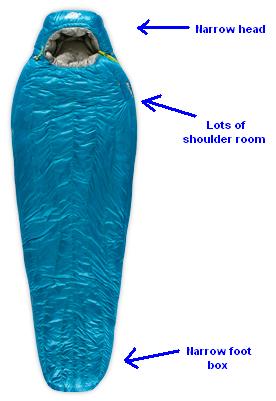
SEMI-RECTANGULAR SLEEPING BAGS
Tapered from top to bottom to save weight and increase warmth, semi-rectangular bags are a good compromise between rectangular bags and mummy bags. If extra wiggle room is more important to you than minimizing weight, this may be your bag shape.
ZIPPER LENGTH
Extremely ultralight bags sometimes shave ounces off by providing a very short main zipper, or even eliminating it altogether. You will have to weigh the convenience of a full-length zipper against the savings in weight you get with a partial-length zipper when choosing your new bag.
INSULATED COLLARS AND DRAFT TUBES
An insulated collar helps keep the warm air that your body has heated up from escaping through the head opening.
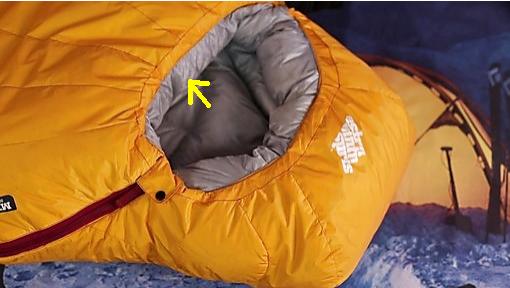
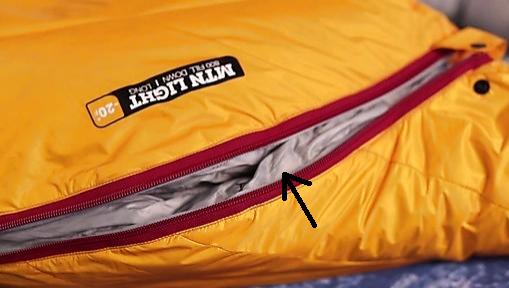
USER HEIGHT
Don't cut the user height too closely. If a bag is recommended for people up to six feet, and you are exactly six feet, try graduating up a size. Extra height also lets you store water bottles and clothing inside the bag when winter camping.
WOMEN'S SLEEPING BAGS
Women-specific bags are cut more narrowly at the shoulders, slightly wider at the hips, and the insulation is distributed in a way that's different from a men's bag. Women's sleeping bags are also typically shorter.
COLD-WEATHER ALTERNATIVES
Instead of buying an expensive winter bag that can be used only in cold weather, you could pair two 3-season sleeping bags together instead. This economic option works best if one of the bags is mummy shaped and the other semi-rectangular.
DON'T FORGET THE SLEEPING PAD!
As you lie in your bag, your body compresses the insulation underneath, greatly reducing its ability to trap air. A foam sleeping pad compensates by insulating you from the cold ground below. (Some manufacturers don’t even bother insulating the bottom of their sleeping bags anymore since they assume you’ll have a sleeping pad anyway.)
